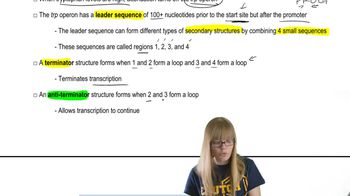Transcriptional regulation of operon gene expression involves the interaction of molecules with one another and of regulatory molecules with segments of DNA. In this context, define and give an example of each of the following:
corepressor
Table of contents
- 1. Introduction to Genetics51m
- 2. Mendel's Laws of Inheritance3h 37m
- 3. Extensions to Mendelian Inheritance2h 41m
- 4. Genetic Mapping and Linkage2h 28m
- 5. Genetics of Bacteria and Viruses1h 21m
- 6. Chromosomal Variation1h 48m
- 7. DNA and Chromosome Structure56m
- 8. DNA Replication1h 10m
- 9. Mitosis and Meiosis1h 34m
- 10. Transcription1h 0m
- 11. Translation58m
- 12. Gene Regulation in Prokaryotes1h 19m
- 13. Gene Regulation in Eukaryotes44m
- 14. Genetic Control of Development44m
- 15. Genomes and Genomics1h 50m
- 16. Transposable Elements47m
- 17. Mutation, Repair, and Recombination1h 6m
- 18. Molecular Genetic Tools19m
- 19. Cancer Genetics29m
- 20. Quantitative Genetics1h 26m
- 21. Population Genetics50m
- 22. Evolutionary Genetics29m
12. Gene Regulation in Prokaryotes
Tryptophan Operon and Attenuation
Problem 7
Textbook Question
The trpL region contains four repeated DNA sequences that lead to the formation of stem-loop structures in mRNA. What are these stem-loop structures, and how do they affect transcription of the structural genes of the trp operon?
 Verified step by step guidance
Verified step by step guidance1
Understand the trp operon: The trp operon in bacteria is a group of genes involved in the biosynthesis of tryptophan. It is regulated by transcriptional attenuation, which involves the trpL region.
Identify the trpL region: The trpL region is a leader sequence located upstream of the structural genes. It contains four repeated DNA sequences (regions 1, 2, 3, and 4) that can form stem-loop structures in the mRNA transcript.
Explain the stem-loop structures: The stem-loop structures are formed by complementary base pairing between these regions. Specifically, regions 1 and 2 can pair, regions 2 and 3 can pair, and regions 3 and 4 can pair. The pairing of regions 3 and 4 forms a terminator stem-loop, which halts transcription.
Describe the role of tryptophan levels: When tryptophan levels are high, the ribosome quickly translates the leader peptide encoded by the trpL region, allowing regions 3 and 4 to pair and form the terminator stem-loop. This stops transcription of the structural genes.
Explain the alternative pairing: When tryptophan levels are low, the ribosome stalls at the trp codons in region 1, allowing regions 2 and 3 to pair instead. This prevents the formation of the terminator stem-loop, allowing transcription of the structural genes to proceed.
 Verified video answer for a similar problem:
Verified video answer for a similar problem:This video solution was recommended by our tutors as helpful for the problem above
Video duration:
2mPlay a video:
Was this helpful?
Key Concepts
Here are the essential concepts you must grasp in order to answer the question correctly.
Stem-Loop Structures
Stem-loop structures are secondary RNA structures formed when a single strand of RNA folds back on itself, creating a double-stranded 'stem' and a loop. These structures play a crucial role in the regulation of gene expression, particularly in prokaryotes, by influencing the stability of mRNA and its interaction with ribosomes.
Recommended video:
Guided course

Ribosome Structure
trp Operon
The trp operon is a group of genes in bacteria that are involved in the biosynthesis of the amino acid tryptophan. It is regulated by a feedback mechanism where the presence of tryptophan inhibits the transcription of the operon, allowing the cell to conserve resources when tryptophan is abundant.
Recommended video:
Guided course

Trp Attenuation
Transcription Termination
Transcription termination is the process by which RNA polymerase stops synthesizing RNA and detaches from the DNA template. In the trp operon, the formation of stem-loop structures in the mRNA can signal RNA polymerase to terminate transcription prematurely, thereby preventing the synthesis of downstream structural genes when tryptophan levels are sufficient.
Recommended video:
Guided course

Prokaryotic Transcription
Related Videos
Related Practice
Textbook Question
430
views


